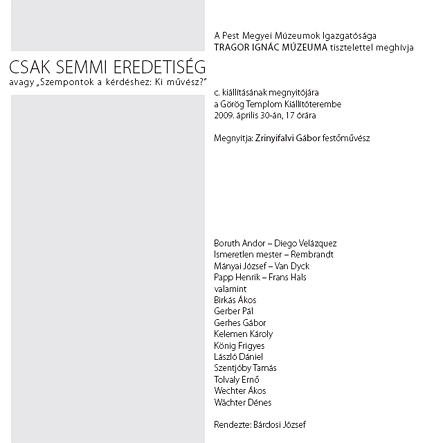Greek Church Exhibition Hall, 1. May - 14. June 2009.
The reception of art is based on the dynamics of perception, or in some cases, on the conscious deception of perception. It is not only an aesthetic-optical, but an art historical and philosophical question: shall we put emphasis on the “seen” or on the “known”?
Art in the Middle Ages visualized the “known.” Later, until modernism, art presented the empirical, the “seen” world. Following this categorization, we can say the abstract and conceptual tendencies in modernist and contemporary art are related to the spirit of medieval art.
The relation of images to one another adds to the relation of reality and art: the cases of the simple epigone, the hyperrealist painter working on the basis of a photo, the artwork quoting other artworks, the artist mimicking the style of other artists, etc.
Through the parallel presentation of positive and negative examples, the exhibition gave an opportunity to viewers to think about differences between valid art of the pictorial age and products of the identity-crisis of postmodern culture.
These temporary exhibitions are important for the collection, which lacks a permanent show, as they offer a chance to display important works from the expanding repository and provide an opportunity to influence public opinion on the notion of “mimesis.”
Authors of the works on display: Andor Boruth - Diego Velázquez; Unknown master - Rembrandt; József Mányai - Van Dyck; Henrik Papp - Frans Hals, Ákos Birkás, Pál Gerber, Gábor Gerhes, Károly Kelemen, Frigyes Kőnig, Dániel László, Tamás Szentjóby, Ernő Tolvaly, Ákos Wechter, Dénes Wächter.

